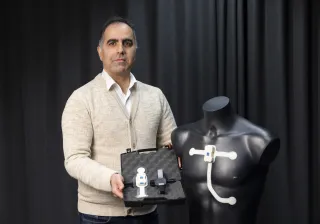The use of artificial intelligence, robotics and other ever-advancing technology is still in its infancy with regard to home care and other services for senior citizens living independently at home. This is surprising, as the growing need for senior services has long been evident.
However, the coronavirus pandemic has shown that the care sector also evolves quickly when necessary: remote connections and virtual care were suddenly worth their weight in gold. Although the pandemic will hopefully pass, the need to overhaul care services will not.
Technology increases wellbeing in social work, healthcare and the customer’s own home
Soon, there will not be enough people to provide care services. A third of all practical and general nurses will be retiring within the next ten years. At the same time, senior citizens will require more support and services at home. Approximately 45,000 additional employees are required for senior services – using the current model. Combined with other developments in the sector, service innovations based on remote connections, sensors, artificial intelligence and robotics may attract new recruits to the field, and fresh career prospects may keep old-hands at work for longer. Technology is a cornucopia of new service models.
Technology helps seniors to participate and remain active, delaying the moment when heavy care services will be required.
Switching from independent living to home care is already a major transition that technology can smooth. Before entering home care, senior citizens can benefit from a variety of early-stage support services and applications that will help them to maintain their ability to function. A variety of digital services powered by video connections are already becoming more commonplace – such as group activities, virtual cafés, participation in cultural events and visits from relatives – and they provide increased opportunities for seniors to get involved, enjoy new experiences and have their say from home. Using technology to monitor your wellbeing and activeness provides both information and motivation to take even better care of your own health.
AI boosts effectiveness
Thirdly, technology quite simply improves the quality and effectiveness of home services. Artificial intelligence, sensor data and information collected by senior citizens themselves could be combined to ensure that personal and preemptive service is provided at the right time. At the same time, extensive health and wellbeing data is required for effective management, forecasting and impact assessments. This data is essential for public service provision.
Technology companies will encounter many interesting opportunities to create new concepts and see their ideas realised in housing and home care. Virtual care services, medicine-distributing robots and remote monitoring devices are all rapidly becoming widespread, but are still only the first step in the digitalisation of independent living for seniors. Although the hype surrounding care robotics has already peaked, development work is continuing: for example, conversational AI and social robotics will once again bring new kinds of experiments into the home environment. Advances in robotics outside the health and social care sector are also being harnessed in independent living. Autonomous vehicles, remote-controlled mobile robots, and sensors and devices integrated into buildings and the environment can all be used in the provision of safe mobility services for residents with dementia or restricted mobility.
These concepts will not only be advantageous in Finland: there is vast international demand for innovative and reliable services that will be agreeable to end users.
Home services and independent living must be revamped in tandem
Concerted action will be required to fully harness technology and digitalization in home service provision and independent living. The need for senior care services and the provision of public services are issues that affect society as a whole, and various parties’ perspectives must be taken into account when these services are overhauled. Both the customers themselves and those close to them should be included in the development and piloting of new services, and also when planning their introduction. Technological competence must be ensured among professionals in the health and social care sector. New kinds of professional roles are required, such as remote home carers, whose tasks will include monitoring a customer’s condition via remote connections and monitors, and then forwarding information to carers making physical visits. New professions in home care, combined with the aforementioned early-stage services, will completely revamp the home care provision process so as to make more extensive use of technology.
The Wellbeing and Health Sector Artificial Intelligence and Robotics Programme (aka the Hyteairo programme) was launched by the Ministry of Social Affairs and Health and is being steered by the National Institute for Health and Welfare. The programme has provided a significant platform for networking, cooperation and discussion with regard to the role of technology in the health and social care sector, and particularly in independent living. It has already formulated a national operating model and IT system package (aka the KATI model) for the extensive utilisation of technology in services for independent living at home . This model will start to become reality as it is applied and implemented through further collaboration between various parties. The Hyteairo programme would like to extend an invitation to all customers, care sector professionals, health and social care organisations, technology companies, and education and research operators: let’s lead the digitisation of independent living together.





